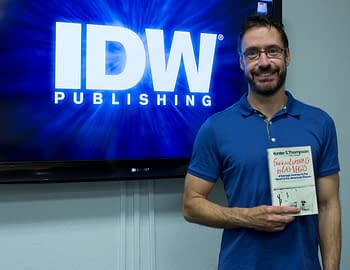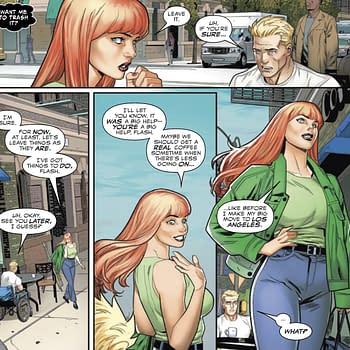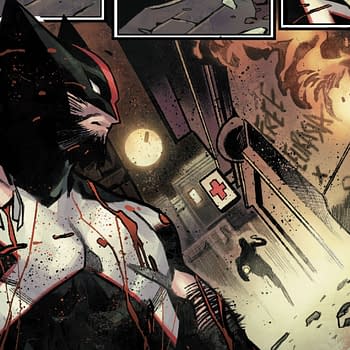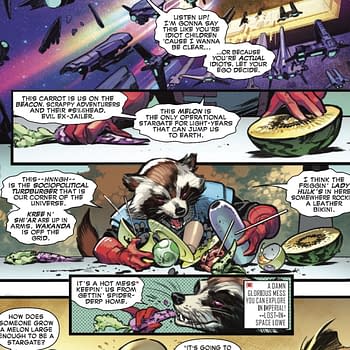Posted in: Comics | Tagged: Comics, dark horse, dark horse comics, entertainment, eric stephenson, idw, image, image comics, mike richardson, ted adams
Dark Horse's Mike Richardson And IDW's Ted Adams Respond To Eric Stephenson's ComicsPRO Speech

On Friday, Bleeding Cool ran a speech by Eric Stephenson, publisher at Image Comics, to the gathered retailers at the ComicsPRO event in Atlanta, Georgia. You can read the whole text here. Eric Stephenson was also handed the 2014 ComicsPRO Industry Appreciation Award.
Specifically mentioning that Star Wars, GI Joe and Transformers comics "will never be the real thing" and saying "we don't want people buying their comics in Targets or Wal-Marts, or as a giveaway with a toy" it seems there were two other specific publishers' programming plans that were referred. So Bleeding Cool asked Mike Richardson, Publisher of Dark Horse Comics and Ted Adams, publisher of IDW to respond. While Bleeding Cool's David Dissanayake also added his thoughts.
Mike Richardson writes,

First of all, unlike Eric, I'd love to see comics everywhere: newsstands, airports, bus stations and barber shops, and yes, even in Targets, and Wal-Marts. If Kenner wants to pack comics in with a toy or a studio wants to include them with a movie, God bless 'em. If comics were everywhere, one can only assume that business would also be booming in our Direct Market comic shops. If the market is to truly grow, people need to be exposed to the form. One of the industry's key problems over the last few decades has been the shrinkage in mainstream distribution. (And while I'm on the subject of distribution, despite Eric's claims, the music industry's boxed sets and reissues are a response to diminished sales, not the other way around. Music revenues have dropped for a variety of reasons, but the music and comics business are completely different markets and not directly comparable.)
"Transformer comics are not the real thing." Really? For several decades we've faced the continued loss of younger readers. We need to find ways to bring those kids back in. Eric is rightfully proud of titles such as The Walking Dead and Saga, but those aren't the books that will solve this problem. If a young girl or boy sees a comic at the age of five and it happens to feature the Transformers, great. There's a chance that the child will continue to read comics, maybe over a lifetime. Choice of subject matter does not define a "real" comics reader, the act of reading comics does. And if someone wants to relive something they experienced as a child by reading a G.I. Joe comic, so be it. It's nonsense to say a particular title is not "real" comics simply because it didn't start out as a comic book. So I shouldn't enjoy reading Dynamite's The Shadow because it started out as a pulp magazine?
Eric uses Star Wars as an example of comics that are not "real." That will certainly be news to those creators who produced over 25,000 pages of Star Wars comics and an insult to the people who read them. This kind of thinking smacks of a kind of comics elitism, where self-appointed gatekeepers tell us not only what we should and should not read, but what we should enjoy. People read comic books for a variety of reasons, and in the end the marketplace will decide which comics and which companies will be successful.
Eric takes a shot at super-hero comics and I couldn't agree with him more when talking about creating better comics, but super-hero comics are the reason comics shops are still around, a fact underscored every month in the Diamond Preview top 100. Iconic heroes have been imbedded in cultures since the beginning of human history, and comic books in the 21st century continue the tradition of modern myth-making. Yes, people may know Batman, as he rightly points out, but every so often a Frank Miller comes along with a complete new take and the entire industry is changed. Like all forms of entertainment, some comics are good and some aren't, super-hero or not.
The market will also have the final say on price. $7.99 IS a lot to pay for a comic book. So is $4.99, and $3.99, and even $2.99. Think about it. $2.99 for a comic book generally consisting of 20 to 24 pages of reading material. I'm old enough to remember the final days of the ten-cent comic. A kid could walk into a store and buy 10 comics for a buck. These days the same ten comics would cost at least $30. There are reasons for the rising costs, including creators wanting to make a decent living, licensors wanting to be paid for their IP, increasing costs for once cheap paper, and hopefully, a little something for the publisher after all is said and done. Eric criticizes the $7.99 price point, but isn't the 80 pages of story and art found in an issue of Dark Horse Presents for $7.99 a far better deal than $2.99 for 20 or 22 pages of comics? And if price point is the issue, what explains the growth of graphic novel sales? Once again, the market will decide.
Then there's this quote to retailers: "When you stop buying them (variants), we'll stop making them." It's a real head scratcher. A publisher is 100% responsible for what he publishes. I assume that if a publisher produces variants, it's because he is selling them . . . to retailers. Does it make sense for a publisher to criticize retailers for buying what the publisher is willing to sell them?
Finally, it is disingenuous to dismiss media titles such as Star Wars while singing the praises of The Walking Dead. Yes, the comic created by Kirkman and Moore is a good read. And yes, sales may have been increasing month by month, but there is no doubt about the television series sending large numbers of "civilians" to the bookstores who helped push sales to amazing levels. While The Walking Dead may have originated in comics, its lineage dates back to the classic film responsible for the entire genre . . . George Romero's Night of the Living Dead. It's hard to see how the readers brought to the comic by the TV series are "real" comics readers, while those picking up a Star Wars comic are not.
The bottom line is this: The industry will be best served when it offers all types of comics distributed through all markets in a variety of formats to all types of people throughout the world. A lofty goal, but if we achieve it our comic shops will thrive.
But that's just my opinion, and you know what they say about opinions . . .
Ted Adams, publisher of IDW writes,

It's hard for me to understand why he felt he needed to build his business up by knocking mine down, but let's look at the facts.
Over the last few months:
– My Little Pony has brought in tens of thousands of new readers to comic shops. I've been traveling a lot in the US and every city I visit, I stop in to the local shops to learn what's working and what isn't. Every single store I've visited tells me that MLP comics have brought kids into their shops in a way that no other title has. This has led many stores to start or increase the size of sections aimed directly at kids. In case it's not obvious, over time, kids reading comics turns into teenagers and adults reading comics. We all had to start reading comics somewhere and even though those comics aren't "real" in Eric's world, they are for the kids who love them.
– IDW pioneered the Micro Comic Fun Pack last fall and shipped over 500,000 comics to every mass retailer including Target, Toys-R-Us, Wal-Mart, and many more. Why is this important? Every one of those Fun Packs have ads that drive those new readers to comic stores.
– IDW titles are regularly sold through Scholastic Book Fairs and Books Clubs. This season we have books featuring My Little Pony, Transformers, and Teenage Mutant Ninja Turtles. The print runs of each one of those books is 3 or 4 times the best-selling comic in the direct market. Why is this important? Because if the kids who buy those books at school want more, the next place for them to buy them is their local comic shop.
– We currently have IDW comics in Hasbro's Transformers toy line. Those comics tie into our current continuity and again have ads that tell new readers what books they should try and how to find their local comic shop.
With that being said, IDW is consistently acting as a feeder system to the direct market and the idea that only Image comics can bring new readers into comic shops is so insulting to everyone in the channel that it's hard for me to figure how Eric thought it was a good idea to build a speech around it. It's also hard for me to figure how he thought it was a good idea to insult hundreds of creators and hundreds of thousands of fans by telling them their comics books aren't "real".
Since Eric wants to talk creator-owned books now is a good time to remind everyone that Locke & Key just spent it's 3rd week at the top of the New York Times Bestseller list and that we've got some great new creator-owned comics launching from April to September:
The Beautiful War by T.P. Louise and Ashley Wood (April). This comic series, the first of many new Ash titles for us in 2014, finds him re-teamed with his writing partner from Lore.
V-Wars by Jonathan Maberry and Alan Robinson (May). Spinning out of the prose anthology by Maberry, and launching with a zero issue this Free Comic Book Day, V-Wars tells the story of what happens when a virus unleashes hidden parts of our genes that cause vampirism. Every culture has it's own vampire myths and V-Wars explores them.
Winterworld by Chuck Dixon and Butch Guice (June). Chuck returns to the world he created with Jorge Zaffino.
Ragnorak by Walter Simonson (July). Norse Mythology by the master.
Little Nemo in Slumberland by Eric Shanower and Gabriel Rodriguez. Two creators at the top of their game updating one of the best comic strips of all time.
The October Faction by Steve Niles and Damien Worm (September). An ongoing horror comic from the master of the form and his artistic partner from our recent release, Monster & Madman.
What do you think, Eric? Are those comics "real"?
David Dissanayake, Senior San Francisco Correspondent at Bleeding Cool writes,
Eric Stephenson was spot on when he said this at his now famous ComicsPro speech:
"More than that, we need to look at who our customer base is – not just who is coming into the stores, but who ISN'T – and ask what we can do to make our marketplace more appealing to them. ANYONE who isn't currently buying comics should be our target audience. THAT is who we want coming into comic book stores, and it is new creativity that is going to pave their way to your door."
He's absolutely right: ANYONE who isn't currently buying comics should be our target audience. The question then becomes, how can we reach out to those people? How do non-comics-readers perceive the comics medium, and what is it about that perception – or lack of perception – that keeps them away from comic stores?
It seems, in my humble experience, most people who don't read comics in America don't do so because they associate "comics" with "superheroes," and outside the movies most people don't have an interest in superheroes (there are other reasons too – price being one – but let's stick with the superhero association for now). I'm sitting here writing this on my roof with my three roommates, none of whom read comics. When I asked them what the first thing they thought of when they heard the word "comics," every single one of them answered "superheroes."
Image is a publisher with a catalogue that could bring almost every one into comics. They have comics for almost anyone's tastes. The problem? Most people outside of comics have never heard of any of the books. How can Image change that?
Start with something simple: the decorations and posters you find in most comic stores. Many stores – the majority, I'd wager – are plastered with posters from the Big Two. I can think of a half dozen stores I've frequented in the past few months that are draped in the posters of Marvel Now and The New 52. These are full sized posters too – impossible to miss – and the reason they are everywhere is because Marvel and DC give these away to stores FOR FREE. Stephenson even mentioned this in his speech, that the first thing you often see when you walk by or into a comic store is Spiderman or Superman in their tights.
It is no wonder to most people, comics = superheros.
No wonder American comics don't have the level of cultural acceptance that BD enjoy in France or Manga in Japan.
Where are the giant Saga posters? Where are the oversized East of a West, Velvet, Pretty Deadly, and Rat Queens posters? Sure, there are the small ones that Image sends out when a new title comes out, but where are the full-sized, eye grabbing, impossible-to-miss posters for stores to put in their front windows?
Image can do more to help the industry and the market, as a start, by printing some cool posters and sending them to retailers so they have something to put up instead of superheroes. Help them make their stores look good with all of the already-incredibly-attractive Image titles. The industry needs to have people see these kind of books when they walk in to the front-lines of our beloved medium: the Local Comic Store.
Obviously this is a cultural campaign that is way beyond the scope of just Image Comics, or any other lone publisher for that matter, but Image certainly have a lot to offer to help start the process. Begin in the comic stores, and then move into magazine and newspaper ads, speaking tours, sponsored book clubs, partnerships with school and public libraries, or perhaps giving discounts to retailers for sales where retailers can offer a complete series or lots of trade paperbacks for much cheaper. There are so many options and creative ways to expand the visibility of comics, and there is a lot that Image could do to help show people that comics are so much more than people in tights punching things. It sounds really simple, but good place to start for Image is by providing retailers with new innovative ways to advertise in their stores in a way that is more appealing and attractive to non-readers.
When we start to change the way non-readers think about comics, they' will be drawn in to this wonderful, mad, creatively vibrant medium. Image has a lot to gain by continuing to help retailers and expanding the visibility of their line and comics in general. When that starts to happen we'll see sales start to rise, and rise, and rise, and rise.
David Dissanayake is Senior San Francisco Correspondent at Bleeding Cool. Give him a shout on Twitter @dwdissanayake
And for me, Rich Johnston, I have my own biases. I enjoy more comics from Image Comics than from any other publisher. But I take issue with some of Eric's statements too. Is the Walking Dead "the real thing"? I ask, because many people have come to that comic as a result of seeing the TV show. They may not be looking for a comic, they just "want more" Walking Dead. But Image Comics has used that as a way for pushing and promoting other books alongside Diamond Book Distributors, and Saga is a direct beneficiary of that.
In the end, a sale is a sale, a dollar is a dollar, but any way that new people are brought to comic stores, is an opportunity to bring them into the fold.
Also, last year, Image published MacGyver.
Update, thanks to Matt and Annette Price for the shot of Eric Stephenson.











